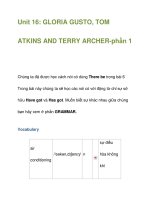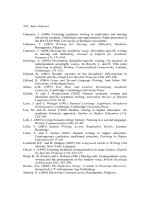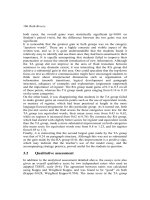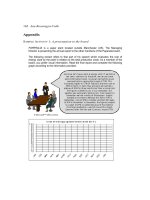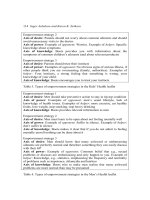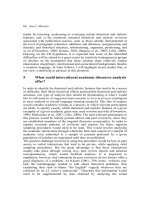English for Professional and Academic Purposes phần 1 ppt
Bạn đang xem bản rút gọn của tài liệu. Xem và tải ngay bản đầy đủ của tài liệu tại đây (1.41 MB, 24 trang )
English for Professional and
Academic Purposes
Utrecht Studies in Language and Communication
22
Series Editors
Wolfgang Herrlitz
Paul van den Hoven
English for Professional and
Academic Purposes
Edited by
Miguel F. Ruiz-Garrido
Juan C. Palmer-Silveira
Inmaculada Fortanet-Gómez
Amsterdam - New York, NY 2010
Cover photo: Morguele.com
The paper on which this book is printed meets the requirements of “ISO
9706:1994, Information and documentation - Paper for documents -
Requirements for permanence”.
ISBN: 978-90-420-2955-2
E-Book ISBN: 978-90-420-2956-9
©Editions Rodopi B.V., Amsterdam – New York, NY 2010
Printed in The Netherlands
Contents
Current trends in English for Professional and Academic
Purposes
Miguel F. Ruiz-Garrido, Juan C. Palmer-Silveira and
Inmaculada Fortanet-Gómez
1
Section I. Discourse analysis of English for academic purposes
Formality in academic writing: The use/non-use of phrasal
verbs in two varieties of English
Dushyanthi Mendis
11
The ‘dialectics of change’ as a facet of globalisation: Epistemic
modality in academic writing
Carmen Pérez-Llantada
25
Hidden influencers and the scholarly enterprise: A cross-
cultural/linguistic study of acknowledgements in medical
research articles
Françoise Salager-Meyer, María Ángeles Alcaraz Ariza and
Maryelis Pabón Berbesí
43
Researching into English for research publication purposes
from an applied intercultural perspective
Ana I. Moreno
57
Section II. Discourse analysis of professional English
Research reports in academic and industrial research
Philip Shaw
75
Information use and treatment adherence among patients with
diabetes
Ulla M. Connor, Elizabeth M. Goering, Marianne S. Matthias
and Robert Mac Neill
89
“Check it out” – The construction of patient empowerment in
health promotion leaflets
Inger Askehave and Karen K. Zethsen
105
Who “we” are: The construction of American corporate identity
in the Corporate Values Statement genre
Pilar Garcés-Conejos Blitvich
121
Section III. EPAP pedagogy
Evaluating and designing materials for the ESP classroom
Ana Bocanegra-Valle
141
From text to task: Putting research on abstracts to work
John M. Swales and Christine B. Feak
167
Approaching the essay genre: A study in comparative pedagogy
Ruth Breeze
181
Academic writing in the disciplines: Practices in nursing,
midwifery and social work
Julio Gimenez
197
English language education for science and engineering
students
Thomas Orr
213
Notes on contributors 233
Current trends in
English for Professional and Academic Purposes
Miguel F. Ruiz-Garrido, Juan C. Palmer-Silveira and
Inmaculada Fortanet-Gómez
1 Introduction
Specialised languages usually refer to the specific discourse used by
professionals and specialists to communicate and transfer information and
knowledge. There are as many specialised languages as there are professions.
This is what has usually been known as Languages for Specific Purposes or,
when applied to English, English for Specific Purposes (ESP), i.e., the special
discourse used in specific settings by people sharing common purposes. It is
not our aim to define the term or to carry out a historical review of the topic,
as many authors have already done so in the last 50 years (e.g., Gunnarson,
1994; Dudley-Evans and St John, 1998; Engberg, 2006). Neither do we want
to get involved in the debate over whether English for Academic Purposes
(EAP) should be considered a subfield of ESP or if they are now two
different areas of teaching and research within Applied Linguistics. That is
the reason why we are continuing with the term English for Professional and
Academic Purposes (EPAP) introduced by Alcaraz-Varó (2000) (the original
term in Spanish being Inglés Profesional y Académico (IPA)), one of the
most prestigious and prolific scholars in Spain. He rested his view on the
opinion of Widdowson (1998: 4), who stated that “All language use is
specific in a sense”, so that language serves a specific purpose wherever it is
used. Therefore, we agree with Alcaraz-Varó (2000) in the sense that the
term EPAP is much clearer and more specific to cover the domain we are
dealing with here.
The relevance of English in academic and professional settings began some
decades ago, in the 1960s, and it has not decreased. Orr (2002: 1) said that
ESP “is an exciting movement in English language education that is opening
up rich opportunities for English teachers and researchers in new professional
domains”. The spread of science and technology all over the world, together
with the globalisation of the economy and the fact that the university world is
becoming more international, has all helped to make the English language the
current lingua franca of international communication. Despite the research
carried out so far in the field, we still believe that much more ought to be
conducted. As Orr (2002: 3) also points out:
Miguel F. Ruiz-Garrido et al. 2
If systematic attention to actual needs continues to be its hallmark, ESP will clearly
advance further in its study of specialized English discourse and in its development of
effective methodologies to teach it.
From the title of the book it can easily be inferred that our volume is
concerned with two main areas: Academic Purposes and Professional
Purposes. Following Ypsilandis and Kantaridou (2007: 69), EAP “refers
mainly to the academic needs of students and of future professionals who
would seek a career in the academic environment” and English for
Professional Purposes (EPP) refers to “the actual needs of (future)
professionals at work”. As this distinction is currently widely accepted by
many scholars, it is also true that those two broad fields or categories also
involve many different areas and fields of interest and research.
EPAP can cover hundreds of research topics as well as put them into practice
in hundreds of academic and professional settings. For example, Hewings
(2002) showed that EAP, including EST (English for Science and
Technology), was the most common field of research in the ESP Journal and,
at the same time, he found that text and discourse analysis was the most
common topic scholars wrote about in the period of time observed. Hewings
(2002) concluded by highlighting some new trends for the future, such as
geographical internationalisation of authorship, analysis of more specific
contexts, continued influence of genre analysis or corpus analysis, and the
effect of English as an international language. A few years later, in an
editorial of the ESPj, Paltridge (2009: 1) stated that:
ESP research is clearly not the property of the English-speaking world, nor is it taking
place solely in English-speaking countries. In ESP, English is the property of its users,
native and non-native speakers alike, something that was called for some years ago by
Larry Smith (1987) in his discussions of the use of English as an international language.
The present volume is a clear example of this international language and the
geographical variation of authorship. Contributors are currently based in
Europe, America and Asia, and they are a mixture of native and non-native
speakers of English (if we can still maintain such a difference).
Some years earlier, Dudley-Evans and St John (1998: 19) said that “ESP is
essentially a materials- and teaching-led movement” closely interlinked with
Applied Linguistics and English Language Teaching. When looking deeper
into the research trends or approaches in ESP, they refer especially to register
analysis, rhetorical and discourse analysis, analysis of study skills, and
analysis of learning needs. Similarly, and complementing Dudley-Evans and
St John’s ideas, Ferguson (2007: 9) pointed out that:
a key motif in ESP/EAP research has been “difference”: difference between academic
disciplines, between professions, between genres and registers, between discursive
practices; differences that, quite justifiably, have been explored in ever finer detail
Current trends in English for Professional and Academic Purposes 3
drawing on ethnography, corpora and well as more traditional techniques of discourse
analysis.
Many of the approaches used in the research and teaching of EPAP are
illustrated in the present volume. Although certain approaches, such as genre
analysis (Swales, 1990; Swales and Feak, 1994) or contrastive rhetoric
(Connor, 1996), are shown as relevant in the volume, other aspects such as
corpus linguistics, textual analysis, rhetorical analysis, interculturality/cross-
culturality or the use of ethnographic tools are not neglected.
As for the fields of study, the contents of this book illustrate research on
discourse and the teaching/learning process in different academic genres
(research articles, acknowledgements or essays), and in some professional
areas, such as business, health science, or science and engineering.
Concerning the pedagogical implications and applications of the research, we
have devoted one section to this issue, apart from the specific references to
the teaching/learning ideas included in most of the articles in the book. Some
authors state that the application of research findings to teaching seems to be
relatively limited (Poncini, 2006; Bocanegra et al., 2007), so we considered it
necessary to include some articles dealing exclusively with teaching and
learning the language. This section includes suggestions and tips on how to
create materials, how to teach the writing of abstracts or essays better,
different genres in discipline-specific writing, or the description of successful
practices and a programme on English for Science and Engineering.
The group of researchers who lead the present project belong to the research
group GRAPE (Group for Research on Academic and Professional English)
and have been working on different EPAP projects for more than fifteen
years. The selected contributors have different geographical origins, but all of
them have proved to have an unquestionable level of scholarship in the ESP
academic world. The aim of this book is to offer an overview of several
topics within the domain of discourse analysis applied to English for
professional and academic purposes. This volume is not intended to cover all
the issues within ESP but to show current trends in the research being carried
out on the field and to offer new ideas for the future. The chapters included in
the present volume show diverse perspectives in specific English language
research, from topical points of view (abstract writing, essay writing, health
discourse, etc.) or from methodological standpoints (cross-cultural studies,
contrastive rhetoric, corpus linguistics, etc.). English is an international
language and is considered the language of communication in the academic
and professional worlds, and our volume supports that idea by offering
diverse cross-cultural and international perspectives on the topic. Therefore,
the general aim of this volume is to show how the English language is
analysed as both the discourse of and for effective communication in
academic and professional settings. At the same time, it also seeks to find out
Miguel F. Ruiz-Garrido et al. 4
ways of applying the research to the teaching and learning of the English
language.
We hope this new manuscript about the research and teaching of EPAP will
be helpful for those involved or interested in the field. It is our aim that the
contributions compiled in this book not only reflect different fields of current
research but also disclose possible lines of work for the short-term future.
2 Contents
The first section of the volume is devoted to some topics of written academic
English, from very specific language features to more generic studies based
on academic genres. The second section deals with discourse in professional
settings and how it may help professionals to improve their communicative
skills. In the final section, we move into a more pedagogical standpoint of
ESP, with examples of applications of research to the teaching of English.
In the first part of the book, four chapters present an overview of academic
writing as an outcome of the work of international researchers. The authors
of these chapters are mainly concerned with the difficulties users of English
as a lingua franca may have when competing for publication with native
speakers of that language.
The first chapter on EAP comes from Asia, from Sri Lanka, and deals with
one of the most relevant topics at the moment in that part of the world,
namely, the identification of peculiar characteristics of their own variety of
English. In this chapter, Dushyanthi Mendis compares the use of phrasal
verbs in academic and non-academic writing in Sri Lankan and British
English. In order to frame her research, Mendis provides data from a survey
in which most of the speakers of Sri Lankan English identify their language
as a different variety to the one spoken in other parts of the world, though
they still see British English – the colonial language – as the target language
to be taught in schools. Mendis’s results suggest that there is a different use
of phrasal verbs in non-academic writing in Sri Lankan and British English.
However, no relevant differences can be found when academic written
discourse is compared. For this author, this indicates that although Sri
Lankan English has evolved into a differentiated variety of English in more
informal written genres, the hegemony of the British and American varieties
of English in academic writing remains unchallenged for the moment.
The second chapter, by Carmen Pérez-Llantada, is a contrastive analysis of
the use of epistemic lexical verbs by NS and NNS writers of research articles
in English. She hypothesises that NNS may be at a disadvantage because they
do not have a good mastery of frequency, functional and pragmatic intentions
in the use of epistemic lexical verbs and this may have an influence on their
acceptance rate for publication in an English-only research world. However,
her results seem to prove that academic English is no longer so standardised
Current trends in English for Professional and Academic Purposes 5
but is subject to culture-specific variability, which is not an obstacle for
publication, since the articles analysed were published by Spanish researchers
in prestigious biomedical journals.
In the third chapter, Françoise Salager-Meyer, María Angeles Alcaraz Ariza
and Maryelis Pabón Berbesí present an article dealing with the
acknowledgment sections of medicine research articles in four research
publication contexts: Venezuela, Spain, France and USA. They argue the
importance of these sections in medicine articles and analyse the differences
that can be found when comparing the four contexts. However,
acknowledgements are much less frequent and much shorter in non-English-
medium journals and this seems to be due to cultural factors rather than to
academic conventions.
The fourth chapter in this section deals with a contrastive analysis of
academic writing. Ana I. Moreno claims the need to study the differences
between the rhetoric habits of efficient Spanish and English writers, which
should be observed, described and explained in a comparative way. This
study should be complemented by questionnaires or interviews, which would
shed light on the reasons why authors choose certain rhetorical expressions in
their own language and not others. The results of this research can be very
useful for teachers of English for research purposes, whose aim is to provide
researchers with the necessary skills to produce efficient samples of research
writing.
The second part of the book, devoted to Discourse Analysis within a
professional framework, pays attention to the different genre repertoires that
anyone can see when fulfilling their everyday professional duties. Thus, the
most important aspect of this section is that all the contributors have based
their efforts on the study of the English language that arises naturally within
the professional settings analysed. In the four chapters forming this second
section of the volume, the authors pay attention to different types of
discourse observed in professional settings.
To start with, Philip Shaw observes how Swedish industrial doctoral students
manage with writing, and how they improve their ability to do so when they
are able to pay attention to its production conditions, as well as to their
prospective audience. Technical reports, due to their high level of
complexity, are discussed in detail by students in semi-structured interviews,
in order to observe the fine nuances that take part in their creation. Shaw also
pays attention to the main structural differences with classroom reports,
which students are also compelled to write, thus creating an interesting
writing repertoire.
The concept of audience is a recurrent theme when observing the
contribution by Ulla M. Connor, Elizabeth M. Goering, Marianne S. Matthias
and Robert Mac Neill, as they try to observe how patients manage when
receiving information on the type of medicines they have to use. The type of
Miguel F. Ruiz-Garrido et al. 6
information (both oral and written) offered to these patients is analysed. The
importance of this type of research goes without saying, as patients will only
use certain specific medicines if they can trust the person (or laboratory)
advising them to use them. The authors have observed that patients tend to
rely most heavily on their physicians, whereas other sources of information
are not so successful.
The importance of health discourse is also the focus in Inger Askehave and
Karen K. Zethsen’s contribution, where they observe that, within the
professional discourse framework, this could be one of the most important
areas, as it includes the analysis of rather diverse genres, from a very specific
basis, i.e. physical and mental well-being. Genres within health discourse
tend to be based, in the authors’ opinion, on the intended target groups, which
in turn rely on the communicative purpose that authors try to enclose within
the message. In any case, legislation also plays a predominant role in order to
show what can (or cannot) be said in this type of texts.
Whereas health discourse tends to focus on the person, corporate discourse
focuses mainly on corporate identity, as Pilar Garcés-Conejos Blitvich points
out. The use of “we” as an indicator of who the company is has been studied
furthering greater detail in her chapter. The way that companies tend to
identify themselves through the use of identity markers such as “we” implies
many different ideas, and Garcés-Conejos Blitvich analyses the use of this
pronoun in fifteen webpages, with a view to ascertaining how corporations
construct their corporate identity by mixing human and social values with
economic interests.
The final section focuses on the teaching of EPAP. ESP has always had a
strong pedagogical bias, which justifies at least one section devoted to
teaching perspectives. This section contains five chapters, three dealing with
academic discourse teaching, and the other two with professional English
tuition.
The first one is related to the teaching of professional English in an academic
context, but it deals especially with a general topic which can be applied to
the following articles: the creation of materials. Ana Bocanegra-Valle
undertakes a thorough analysis of ESP materials, describing and evaluating
existing ones as well as shedding some light on material design. She
complements her description by adding the role that the teacher plays in the
design, development and usage of the material (adapted, self-designed or of
any other kind). She finishes by illustrating her previous explanations with
some material she successfully uses in her classes of English for maritime
purposes.
The second chapter deals with an academic discourse genre (the abstract) and
how to teach it based on a recently published book (Swales and Feak, 2009).
John M. Swales and Christine B. Feak explain several tasks, their purpose
and suggestions about how to develop them. They show them as illustrations
Current trends in English for Professional and Academic Purposes 7
of how to deal with the issue of writing abstracts, which may be of interest to
scholars, researchers and students who are not specialists in English and
regardless of their geographical origin. The main purpose of the tasks is to
raise rhetorical awareness about the role of research article abstracts.
Also in an academic context, Ruth Breeze presents a study which compares
two pedagogical approaches (textual analysis and rhetorical analysis) to
teaching essay writing in English to undergraduates at a Spanish university.
Results show that students in both groups improved, but the rhetorical
analysis group made greater progress over the course of the programme, and
wrote better final essays. The final outcome illustrates the complexity of
teaching genre, and the author concludes that teachers in an EFL context
should bring together the linguistic and textual aspects of writing and the
rhetorical dimensions of the writing task, which are arguably more important
for the overall quality of the written product.
In the fourth one, Julio Gimenez examines the teaching of writing on a
discipline-specific academic course. He examines the nature and dynamics of
this academic writing in three disciplines: nursing, midwifery and social
work. He reports on the results of a survey completed by students from each
discipline and the analysis of samples of authentic writing and interviews
with some students and lecturers. His chapter ends with an examination of
the implications for teaching discipline-specific writing that have resulted
from the study.
In the final chapter of this section, Thomas Orr focuses on English for
science and engineering. He begins by describing in specific detail the kind
of English and supporting skills that ought to be taught at universities to
students majoring in science and engineering. He also describes and
illustrates how this kind of English can be taught, which leads him to the in-
depth description of the exemplary programme he directs in Japan. Finally,
he concludes with some recommendations on how the previous information
can be successfully applied in other contexts.
References
Alcaraz-Varó, E. (2000) El Inglés Profesional y Académico, Madrid: Alianza
Editorial.
Bocanegra Valle, A., M.C. Lario de Oñate and E. López Torres (2007)
Preface. In Bocanegra Valle, A., M.C. Lario de Oñate and E. López
Torres (eds) English for Specific Purposes: Studies for Classroom
Development and Implementation, Cádiz: Universidad de Cádiz: 7-
10.
Connor, U. (1996) Contrastive Rhetoric: Cross-cultural Aspects of Second
Language Writing, Cambridge: Cambridge University Press.
Miguel F. Ruiz-Garrido et al. 8
Engberg, J. (2006) Languages for specific purposes. In Brown, K. (ed)
Encyclopedia of Language & Linguistics (2nd edition), Amsterdam:
Elsevier: 678-684.
Ferguson, G. (2007) The global spread of English, scientific communication
and ESP: Questions of equity, access and domain loss, Ibérica (13):
7-38.
Gunnarsson, B L. (1994) Historical studies in different traditions. In Brekke,
M., O. Andersen, T. Dhal and J. Myking (eds) Applications and
Implications of Current LSP Research (vol. 2), Bergen, Norway:
Fagbokforlaget: 897-887.
Hewings, M. (2002) A history of ESP through ‘English for Specific
Purposes’ ESP World (3) 1 <o/Articles_3/
Hewings_paper.htm>.
Paltridge, B. (2009) Editorial, English for Specific Purposes (28) 1: 1-3.
Poncini, G. (2006) Evaluation in written and spoken discourse: integrating
discourse into teaching. In Palmer-Silveira, J.C., M.F. Ruiz-Garrido
and I. Fortanet-Gómez (eds) Intercultural and International
Business Communication. Theory, Research and Teaching, Bern:
Peter Lang: 307-335.
Smith, L. (1987) Discourse across Cultures, Hertfordshire, UK: Prentice
Hall.
Swales, J.M. (1990) Genre Analysis: English in Academic and Research
Settings, Cambridge: Cambridge University Press.
Swales, J.M. and C.B. Feak (1994) Academic Writing for Graduate Students:
Essential Tasks and Skills. A Course for Nonnative Speakers of
English, Ann Arbor, MI: University of Michigan Press.
Swales, J.M. and C.B. Feak (2009) Abstracts and the Writing of Abstracts,
Ann Arbor, MI: University of Michigan Press.
Widdowson, H.G. (1998) Communication and community: The pragmatics
of ESP, English for Specific Purposes (17) 1: 3-14.
Ypsilandis, G.S. and Z. Kantaridou (2007) English for academic purposes:
Case studies in Europe, Revista de Lingüística y Lenguas Aplicadas
(2): 69-83.
Section I
Discourse analysis of
English for academic purposes
Formality in academic writing: The use/non-use
of phrasal verbs in two varieties of English
Dushyanthi Mendis
Phrasal verbs are characteristic of colloquial or informal language and tend to occur
more in conversational speech genres than in academic discourse. Using a single
Latinate verb instead of a phrasal verb is recommended by some EAP practitioners in
the West in order to achieve a more formal tone in academic writing. How universal
is this prescriptive notion? Does it apply to varieties of English that have developed
their ‘own’, semantically unique, phrasal verbs? The distribution of phrasal verbs in a
corpus of Sri Lankan English writing is investigated and compared to a similar
corpus of British English in order to answer this question.
1 Introduction
English for Academic Purposes (EAP) is now accepted as a broad term that
covers many types of academic communicative practices in pre-tertiary,
undergraduate and postgraduate teaching, from designing materials and
constructing classroom tasks to participating in classroom interactions
including teacher feedback, tutorials, and seminar discussions, also writing
journal articles, conference papers and grant proposals, as well as student
essays, examination answers, and graduate theses (Hyland, 2006: 1). Of
these, the texts that are subject to the closest scrutiny and evaluation are those
that are written, not only because it is through such public discourses that
disciplines “authenticate knowledge, establish their hierarchies and reward
systems, and maintain their cultural authority” (Hyland, 2000: 1), but also
because unpublished texts such as examination answers, undergraduate and
postgraduate theses and dissertations are a rite of passage for gaining
membership in different hierarchical levels of the academy. In addition,
written texts have more permanency than their spoken counterparts (e.g., a
lecture or a theses defense) as part of the growing corpus of academic
discourse around the world.
The results of such scrutiny and evaluation can be seen in several areas, one
of which is the identification of several common generic conventions in
different types of academic writing. This has helped to develop new
directions and more effective methodologies in EAP pedagogy, as evidenced
by several textbooks aimed at developing and improving academic writing
skills. (See, for instance, Swales and Feak, 2000, 2004; Bailey, 2003; etc.).
However, this scrutiny has also served to reinforce and establish as standard
the norms, conventions and rhetorical practices of certain academic discourse
communities, especially those situated in the UK and the US. This in turn has
served to disadvantage writers who do not belong to these ‘privileged’
Dushyanthi Mendis
12
communities, and helped to marginalize their disciplinary contributions if
seen as not maintaining the established standards mentioned above. This
situation has not escaped the notice of EAP theorists and practitioners.
Hyland (2006), for instance, quoting Gosden (1992) and Flowerdew (2001)
draws attention to the challenges faced by academics who are not native
speakers/users of British or American English, and whose contributions are
vetted by editors, referees and other gatekeepers who frequently reject non-
standard varieties of English (as they see them to be).
While such gatekeeping mechanisms might have gone unchallenged in the
past, several developments in research, scholarship and the academy, as we
know it, now demand a rethinking of these standards and practices, and most
of all, of the hegemony of British and American English as the universal
language varieties of research and publishing. There are several reasons for
this. On the one hand, graduate student populations in the West are becoming
increasingly diverse, with economic constraints pushing many universities
and other research institutions to actively canvass and recruit international
students who are required to pay higher tuition fees than their local
counterparts. On the other hand, increasing competitiveness among the more
prestigious research universities of the West and a perceived need for
diversity in both critical thinking and scholarship has resulted in the
recruitment of teaching and research staff who are not necessarily from
contexts where English is used as a first or dominant language. Thus, as
observed by Swales and Feak, “the traditional distinction between native and
non-native speakers of English is becoming less and less clear-cut. In the
research world, in particular, there are today increasing numbers of ‘expert
users’ of English who are not traditional native speakers of that language”
(2004: introduction). In addition, other varieties of English such as Indian
English and Sri Lankan English have gained increased recognition and
legitimacy through the field of study and research centered on World
Englishes, and it can be argued that there is no reason why such varieties
should be excluded from consideration in EAP.
This brings us to the central question of this paper: will we see a change in
the traditional written discourse practices of the academy as a result of the
infusion of ‘new’ and diverse voices and discourses, or will these voices
accommodate to established traditions and rhetorical practices in fear of
marginalisation? After all, as Swales (1997) observes in an article
provocatively titled “Lingua franca or Tyrannosaurus Rex?”, “there is a well-
attested tendency of off-center scholars to try and publish their ‘best in the
West’” (cited in Hyland, 2006: 126), probably because they are all too aware
that English is acknowledged as the world’s predominant language of
research and scholarship, and that the most prestigious and cited journals are
published in English. Therefore, if the only way to succeed in gaining
recognition of their work at an international level is to adhere to the rhetorical
Formality in academic writing
13
practices and language use demanded by the gatekeepers of Western
academic publishing, scholars and academics are faced with no choice but to
do so.
Proponents of World Englishes would argue for the promotion of and
development of other varieties of English, and for the acceptance and
legitimization of creative new structures emerging from such varieties.
However, a scholarly movement or discipline which advocates equality and
recognizes more than one variety of English as legitimate may not be
sufficient to initiate a paradigm shift in the traditional norms and conventions
of academic writing, or a change in the ideology underlying the gatekeeping
mechanisms mentioned by Swales (1997). For such a paradigm shift to occur,
writers – whether junior or senior researchers or academics, or graduate or
undergraduate students – must be willing to take a risk in using localized
varieties and forms of English and to continue to do so even in the face of
possible rejection.
2 EAP in Sri Lanka
This paper will focus on an analysis of academic writing in Sri Lanka, a
country where English was introduced in the early nineteenth century as a
result of British colonisation. Although the input variety was British English,
the English used in Sri Lanka today, referred to as Lankan English (Kandiah,
1981) or Sri Lankan English (SLE), has features distinct from British English
in terms of grammar, syntax and lexis as several descriptive as well as
corpus-based studies have argued (Kandiah, 1981; Fernando, 2003; Meyler,
2007; Mendis and Rambukwelle, 2010). This is not surprising, given that
English has been used as a vehicle of creative expression in Sri Lanka for
many years, as demonstrated by a substantial body of literature in English
produced by Sri Lankan authors from the beginning of the twentieth century;
English is also the vehicle for research and scholarship in a variety of
disciplines, with several academic journals of repute being published in
English within Sri Lanka. The question, however, is what type or style of
English is used for academic writing. Does the fact that Sri Lanka does
provide opportunities for publishing in English (albeit not on the scale of
India, Malaysia, etc.) empower writers to use a localized variety (i.e., SLE),
or do they feel the need to avoid localized forms and adopt a medium of
expression that is perceived as more ‘international’ or ‘standardized’, and
which approximates the prescriptive norms of EAP?
This question will be investigated by focusing on a lexico-grammatical
feature which according to Celce-Murcia and Larsen-Freeman (1999) is
ubiquitous in informal registers of English, but which, according to Swales
and Feak (2004: 18) is not very frequently found in academic writing as it is
seen as a marker of informality:
Dushyanthi Mendis
14
English often has two (or more) choices to express an action or occurrence. The choice
is often between a phrasal verb (verb + particle) or a single verb, the latter with Latinate
origins. Often in lectures or other instances of everyday spoken language, the verb +
particle is used. However, in written academic style, there is a tendency for academic
writers to use a single verb whenever possible. This is one of the most dramatic stylistic
shifts from informal to formal style.
Phrasal verbs are, as indicated in the excerpt above, two or three-part
structures which consist of a verb followed by what looks like a preposition,
but which is commonly described as a ‘particle’, as it cannot be separated
from the main verb. A unique semantic feature of phrasal verbs is that the
verb + particle combination creates a meaning that is often non-
compositional – i.e., it is not the meaning that would be derived by taking the
individual meanings of the two parts and putting them together. This has led
to the argument that phrasal verbs are metaphorical in nature, and are similar
to other idiomatic formulaic expressions in English.
Phrasal verbs are interesting to this study for another reason: as is the case of
other varieties of English, they are ubiquitous in SLE as well, especially in
informal and colloquial registers. However, in addition to those that are
readily recognizable, SLE also has several phrasal verbs which in British
English have a metaphorical meaning not found in SLE, as well as a number
of phrasal verbs which in British English would occur not as a phrasal verb
but as a single verb without a particle (Meyler, 2007). A recently published
dictionary of Sri Lankan English illustrates these two cases by means of the
following examples. The first one is the SLE phrasal verb put on meaning ‘to
gain weight’, and the second case is the phrasal verb bring down, used with
the meaning ‘to obtain’ or ‘to import’ in SLE, which in British English would
simply be ‘bring’ (Meyler, 2007: xvii):
[1] You’ve put on quite a bit since I last saw you!
[2] They’re planning to bring down a specialist from the UK.
The existence of such localized or language-variety specific phrasal verbs in
SLE has caused concern among some EAP practitioners and teachers of
English as a second language who have noticed their infusion in some written
academic genres. For instance, the following excerpts, taken from student
responses to a question asked in an MA in English Language Teaching end-
of-semester examination conducted by a tertiary level institution in Sri Lanka
show the use of phrasal verb-type structures which would be labeled ‘non-
standard’ or too informal for academic English from a prescriptive point of
view.
Formality in academic writing
15
[3] It does not mean that the teacher should not give the opportunity to the young children
to come out with their problems, but adolescents may preffere (sic) more if the teacher
gives opportunity to come out with their problems in a friendly manner.
[4] Task Based Language Teaching is one of the contemporary teaching methods that
draws up the attention of the linguists and teaching practitioners at present.
The phrasal verb in excerpt [3] above (come out with) is recognizable as a
structure found in SLE, but if one adheres to Bailey (2003), Swales and Feak
(2004), etc., it should be avoided in academic writing because it has more
formal equivalents – i.e., ‘express’ or ‘articulate’. Excerpt 4 contains a
phrasal verb (draws up) which in British English would simply be expressed
by ‘draws’ to convey the intended meaning, and even in SLE would be
considered non-standard.
3 Method: Research corpus
These data beg the question: does Sri Lankan academic writing in English flout
certain generic and stylistic conventions in terms of the use of phrasal verbs, or
is this use confined to unpublished academic genres written/composed with
minimal preparation (e.g., student examination answers/essays) and which may
perhaps be considered to be products of novice or non-expert writers? To
investigate this question further, data from a pilot corpus of contemporary
written SLE, compiled as part of the International Corpus of English (ICE)
project, was analysed. Referred to as ICE-SL (International Corpus of English
– Sri Lanka), the corpus will consist of 400,000 words of written SLE and
600,000 words of spoken SLE when completed. At present, six of the eight
categories in the written component are available for analysis, totaling 300,000
words. These categories, with the number of words in each, appear in Table 1
below
1
. The categories not yet completed are non-professional writing and
correspondence, which are not within the scope of this study.
ICE-SL Text category Words
W2A – Academic writing 80,000
W2B – Non-academic writing (popular) 80,000
W2C – Reportage (news reports) 40,000
W2D – Instructional writing (for hobbies and skills) 40,000
W2E – Persuasive writing (press editorials) 20,000
W2F – Creative writing (novels and short stories) 40,000
Total 300,000
Table 1. Research sub-corpora
1
As reported for ICE-GB, and which is followed by all subsequently compiled ICE corpora. See
Dushyanthi Mendis
16
Of the published texts, W2A is the most formal written genre in the corpus,
as it contains texts taken from academic journals covering the four areas of
humanities, social sciences, natural sciences and technology. Texts in W2B
are somewhat less formal in tone and style although similar in content. These
texts are taken from magazines, newsletters and monthly publications with
titles like Business Today. W2C and W2E are journalistic texts extracted
from daily and weekly newspapers; W2D contains texts of an instructional
nature, on how to learn a skill or adopt a new hobby. The final category,
W2F, represents creative writing, and includes excerpts from Sri Lankan
novels and short stories. All texts in the corpus are published after 1990.
For the purpose of this study, only the published texts were considered. Thus
the primary research sub-corpus for this study is the texts in the categories
W2A, W2B, W2C, W2D, W2E and W2F. In addition, the same text
categories in ICE-GB, a corpus of contemporary British English, were
searched for purposes of comparison with another variety of English. ICE-
GB, which was released in 1998, is one of the earliest completed ICE
corpora. It contains one million words of written and spoken British English,
recorded between 1990 and 1993.
4 Results
The first step of analysis was to search the corpus for phrasal verbs using
AntConc (version 3.2.1w). Since the number of phrasal verbs in English is
considerable, some means had to be devised to construct an initial list for the
search. This was done in two ways. First, a list was culled from Swales and
Feak (2004), who identify phrasal verbs that have semantic equivalents
which are single verbs, often of Latinate origin. Swales and Feak recommend
that these single verbs are more suited to academic writing as they convey a
more formal tone. This list appears in Table 2 below along with their
frequencies of occurrence in the ICE-SL research sub-corpus. Seven phrasal
verbs mentioned by Swales and Feak were not found in ICE-SL. These are
bring on (to cause), figure out (to determine), go down (to decrease), keep up
(to maintain), look over (to review), run into (to encounter) and show up (to
appear).
Formality in academic writing
17
Phrasal
verb
Single-verb equivalent Freq/1000 ICE-SL text file/s
look at
2
consider 0.04 (14)
3
W2A.012, W2B.001,
W2B.012 (5), W2C.004 (2),
W2C.007 (2), W2E.010,
W2B.031, W2F.010
go up increase 0.03 (8) W2B.012, W2B.031,
W2C.004, W2C.013 (3),
W2E.006, W2E.007
look
into
investigate 0.013 (4) W2C.014, W2D.002,
W2E.005 (2)
make up constitute 0.007 (2) W2C.018, W2E.009
get rid
of
eliminate 0.007 (2) W2D.013, W2F.013
find out discover/investigate 0.007 (2) W2B.031, W2F.010
Table 2. Frequencies of phrasal verbs listed by Swales and Feak (2004)
Secondly, a further list of phrasal verbs was culled from A Dictionary of Sri
Lankan English (Meyler, 2007). Some of these phrasal verbs are distinctive
to SLE in terms of structure (e.g., cope up with) while others are distinctive
in terms of meaning (e.g., make out). The meaning of each phrasal verb as
conveyed by their use in SLE, corroborated by Meyler (2007) as well as by
corpus concordance data, is provided in the table below. Once again, seven
phrasal verbs mentioned by Meyler as being distinctive to SLE were not
found in the research sub-corpus. These were bring down (meaning to
import), bear up (to endure), finish up (to complete), fall onto (to join), go
behind (to chase after someone) and go down (to lose weight).
Phrasal
verb
Meaning in SLE Freq/1000 ICE-SL text file/s
put on gain weight 0.007 (2) W2D.015, W2F.017
cope up with endure 0.007 (2) W2B.031, W2E.008
caught up involved in 0.007 (2) W2C.009, W2D.002
come out
with
express/articulate 0.007 (2) W2C.019, W2C.020
get back return 0.007 (2) W2F.008, W2F.016
pass out graduate 0.003 (1) W2C.015
2
A wild card search was done to ensure that all lemmas such as looks at/looking at etc. would be
counted. Phrasal verbs with irregular past tense forms (e.g., brought on/went up) that would have
escaped a wild card search were searched for individually.
3
Number of occurrences is given in brackets
